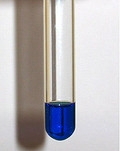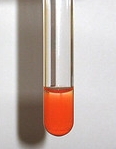

| |
 |
Fehling's
solution is blue due to dissolved Cu2+. The
solution is homogeneous. There is no precipitate. |
| Add glucose | ||
 |
Addition of glucose
causes reduction
of Cu2+ to red Cu2O, forming a
precipitate at the bottom of the test tube. |